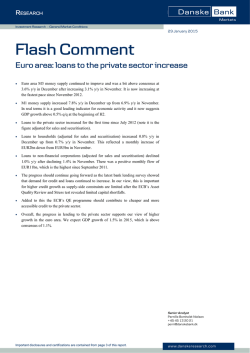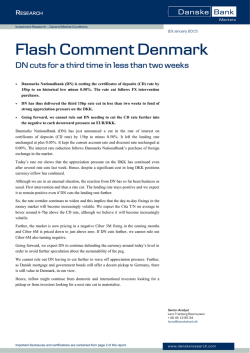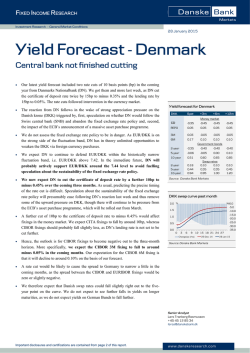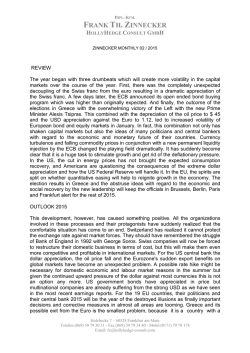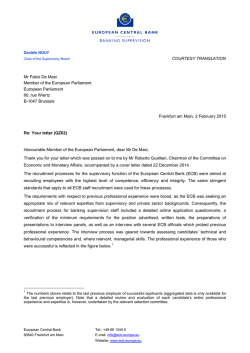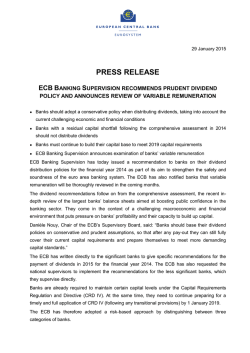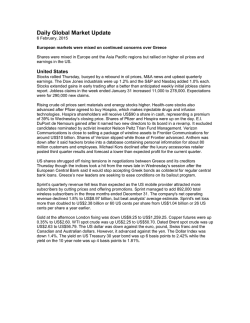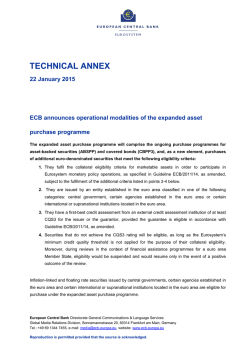
QE Details 1: SMP holdings and cap effects on
Investment Research — General Market Conditions 28 January 2015 QE Details 1 SMP holdings and cap effects on Portugal, Ireland and Greece The details of the announced QE programme were much clearer than we are used to when the ECB launches new measures (see Draghi Delivers: ECB's bazooka in detail and market implications, 23 January. However, there was one topic where Mario Draghi was a bit unclear. The 33% holding cap (including SMP holdings) and the 25% ISIN cap. ECB QE research The caps are likely to have implications only for Greece, before September 2016. GGB purchases will be limited by the caps and not start before the July 2015 redemption. Impact of broad-based QE Portugal is set to be the biggest beneficiary of ECB QE. ECB holdings of PGBs could potentially even exceed the 25% issue cap (including SMP holdings). Portugal is likely to reach the 25% issue limit during Q4 16 but the cap could also be a limitation in core countries such as Germany and Finland if the programme is extended beyond September 2016. Purchases in Ireland, Spain and Italy should not be affected by the ECB caps. Draghi delivers: ECB's bazooka in detail and market implications 23 January 16 January ECB will buy government bonds 15 January Deflation but the good kind 14 January Short-term weakness fades 13 January Recovery despite deflation Details 12 January Our interpretation is that the ECB will buy EUR60bn according to the capital key (around EUR45bn in govies) as long as (1) the ECB holding including SMP purchases does not exceed 33% of outstanding debt (issuer cap) and (2) that purchases in the QE programme will not exceed 25% of outstanding in each ISIN (issue). ECB buying of GGBs to be constrained by 33% issuer cap ECB QE 40% SMP holding ISIN (issue) limit ECB holdings of GGBs 35% 30% ECB QE 33% 15% 10% 10% 5% 5% 0% 0% ECB holdings of PGBs 33% 25% Source: Danske Bank Markets We read Draghi as indicating that SMP purchases will not be included in the 25% issue cap (Draghi was not very clear on this). Our interpretation is also supported by the ECB bothering to announce different cap levels. Above are depicted different ECB holding scenarios (we disregard Italy and Spain) (see detailed assumptions at the end of this document). The ECB could embark on purchases following redemptions and GGB issuance could open the door for ECB purchases (see chart). Important disclosures and certifications are contained from page 4 of this report. ISIN limit (worst case) 20% 15% Source: Danske Bank Markets ISIN (issue) limit 30% 25% 25% SMP holding 40% 35% 25% 20% Holdings of PGB to be below 25% issue cap until Q4 16 Senior Analyst Anders Møller Lumholtz +45 45 12 84 98 [email protected] Analyst Anders Vestergård Fischer +45 45 13 66 41 [email protected] www.danskeresearch.com QE Details 1 Greece cannot be included prior to the July redemption, as the current SMP holdings imply that they will breach the 33% cap. On the other hand, the SMP holdings should not limit purchases in Portugal. In Portugal, ECB holdings (including SMP) could go as high as 29% of gross issuance by September 2016 (10% in SMP holdings and 19% in the QE programme). If the ECB’s programme is extended beyond September 2016, Portugal is likely to breach the 25% issuer limit. Note though that Portuguese switch auctions and higher issuance due to, for instance, IMF repayment could imply that the 25% issue limit would be reached later. Ireland will not breach any of the caps and remain below the 25% limit including the SMP programme. This is also the case for both Italy and Spain. We agree that Draghi’s wording is up for discussion. If the SMP holdings are included in the 25% ISIN cap, the purchases in Portugal could theoretically be affected in mid-2016, depending on upcoming issuance and the composition of the PGB in the SMP holdings. We do not think that the SMP holdings will be included. The limits are at least in part a result of CAC concerns, hence, the ECB’s concerns regarding ISIN should not apply to bonds included in the SMP programme. The SMP programme effectively ended in 2011 (officially with OMT Sept-12), while CAC was implemented in 2013 following the Greek PSI in 2012. Holdings of IRISH set to remain below caps ECB QE SMP holding ISIN (issue) limit 35% 30% 25% 33% SMP holdings ultimo 2013 (see adjustment below) ISIN limit (worst case) EUR bn Issuer country ECB holdings of IRISH 25% December 2012 Nominal Average amount remaining maturity (years) Nominal amount December 2013 Average Dec 2013 remaining holding maturity relative to (years) current outstanding Ireland 14 5 10 5.3 8% Greece 34 4 28 3.4 44% Spain 44 4 39 3.6 6% Italy 103 5 90 4.1 5% Portugal Total 23 218 4 4.3 20 186 3.4 3.9 20% 7% 20% 15% 10% 5% 0% Source: Danske Bank Markets Source: European Central Bank Our interpretation of the ECB cap limits is based on the following statements from Draghi on caps and SMP during the Q&A (there was no information on this in the technical annex). ‘Question: Two questions. You said that you’ll keep buying bonds until inflation is back on track. So, basically, you have an open-ended programme. Do you see anything in terms of the percentage of outstanding debt that you can buy before you start overly influencing price formation on the secondary market, as the European Court of Justice suggested that you should avoid? Draghi: The answer to the first question, yes we will buy government debt up to the percentage that will allow a proper market price formation. Therefore, we have two limits. The first one is an issuer limit, which is 33%, and another one is an issue limit, which is 25%. In other words, we won’t buy more than 25% of each issue and not more than 33% of each issuer’s debt. The 25% limit, by the way, is the one foreseen in order not to be a blocking minority in the collective action clause assemblies, basically bondholders’ assemblies, and it’s the basis for us to be able to say, there is going to be pari passu.’ 2| 28 January 2015 www.danskeresearch.com QE Details 1 ‘Question: My first question would be, it's not actually very explicit here in the press release whether that means that you're not going to buy into Greece's debt right now? Draghi: And to the first question, let me say one thing here. We don't have any special rule for Greece. We basically have rules that apply to everybody. There are obviously some conditions before we can buy Greek bonds. As you know, there is a waiver that has to remain in place, has to be a programme. And then there is this 33% issuer limit, which means that if all the other conditions are in place, we could buy bonds in, I believe, July, because by then there will be some large redemptions of SMP bonds and therefore we would be within the limit.’ Projection assumptions and clarifications The 33% issuer limit: The vertical bars are SMP holdings and ECB QE holdings relative to the gross outstanding debt. If this figure exceeds the 33% cap, the ECB will breach the issuer limit. The monthly figure is adjusted for issuance and redemptions. The 25% issue limit: The solid line is the QE purchases relative to the gross debt in maturities from two to 32 years. The dotted line is our ‘worst case’, as it illustrates the effect if SMP purchases are included in the issue limit. Here we assume the SMP holding in maturities +2Y is distributed, so that ECB holding in all ISINs plus 2Ys are below 25%. As stated above, we do not think that SMP holdings will be included in the issue limit. Projection assumptions Greece Projection assumptions Portugal Greece, EUR bn Portugal, EUR bn Remaining gross issuance 2015 9.0 Remaining gross issuance 2015 8.0 Gross issuance 2016 15.0 Gross issuance 2016 16.0 ECB fraction of SMP bonds maturing before 2016, % 100.0 ECB fraction of SMP bonds maturing before 2016, % 0.35 Gross redemptions March 2015 - 2016 8.8 Gross redemptions March 2015 - 2016 14.3 Source: Danske Bank Markets Source: Danske Bank Markets Projection assumptions Ireland SMP holding assumptions at QE start March 2015 Ireland, EUR bn Remaining gross 2015 9.0 Gross issuance 2016 14.0 ECB fraction of SMP bonds maturing before 2016, % 0.15 Gross redemptions March 2015 - 2016 8.1 EUR bn Issuer country 3| 28 January 2015 March 2015E Nominal Holding amount relative to current outstanding Ireland 10 8% 10 8% Greece 28 44% 22 35% Spain 39 6% Italy 90 5% 20 186 20% 7% 15 15% Portugal Total Source: Danske Bank Markets December 2013 Nominal Dec 2013 amount holding relative to current outstanding Source: Danske Bank Markets www.danskeresearch.com QE Details 1 Disclosures This research report has been prepared by Danske Bank Markets, a division of Danske Bank A/S (‘Danske Bank’). The authors of this research report Anders Møller Lumholtz, Senior Analyst, and Anders Vestergård Fischer, Analyst. Analyst certification Each research analyst responsible for the content of this research report certifies that the views expressed in this research report accurately reflect the research analyst’s personal view about the financial instruments and issuers covered by the research report. Each responsible research analyst further certifies that no part of the compensation of the research analyst was, is or will be, directly or indirectly, related to the specific recommendations expressed in the research report. Regulation Danske Bank is authorised and subject to regulation by the Danish Financial Supervisory Authority and is subject to the rules and regulation of the relevant regulators in all other jurisdictions where it conducts business. Danske Bank is subject to limited regulation by the Financial Conduct Authority and the Prudential Regulation Authority (UK). Details on the extent of the regulation by the Financial Conduct Authority and the Prudential Regulation Authority are available from Danske Bank on request. The research reports of Danske Bank are prepared in accordance with the Danish Society of Financial Analysts’ rules of ethics and the recommendations of the Danish Securities Dealers Association. Conflicts of interest Danske Bank has established procedures to prevent conflicts of interest and to ensure the provision of highquality research based on research objectivity and independence. These procedures are documented in Danske Bank’s research policies. Employees within Danske Bank’s Research Departments have been instructed that any request that might impair the objectivity and independence of research shall be referred to Research Management and the Compliance Department. Danske Bank’s Research Departments are organised independently from and do not report to other business areas within Danske Bank. Research analysts are remunerated in part based on the overall profitability of Danske Bank, which includes investment banking revenues, but do not receive bonuses or other remuneration linked to specific corporate finance or debt capital transactions. Danske Bank is a market maker and may hold positions in the financial instruments mentioned in this research report. Danske Bank, its affiliates and subsidiaries are engaged in commercial banking, securities underwriting, dealing, trading, brokerage, investment management, investment banking, custody and other financial services activities, may be a lender to the companies mentioned in this publication and have whatever rights are available to a creditor under applicable law and the applicable loan and credit agreements. At any time, Danske Bank, its affiliates and subsidiaries may have credit or other information regarding the companies mentioned in this publication that is not available to or may not be used by the personnel responsible for the preparation of this report, which might affect the analysis and opinions expressed in this research report. See http://www-2.danskebank.com/Link/researchdisclaimer for further disclosures and information. General disclaimer This research has been prepared by Danske Bank Markets (a division of Danske Bank A/S). It is provided for informational purposes only. It does not constitute or form part of, and shall under no circumstances be considered as, an offer to sell or a solicitation of an offer to purchase or sell any relevant financial instruments (i.e. financial instruments mentioned herein or other financial instruments of any issuer mentioned herein and/or options, warrants, rights or other interests with respect to any such financial instruments) (‘Relevant Financial Instruments’). The research report has been prepared independently and solely on the basis of publicly available information that Danske Bank considers to be reliable. While reasonable care has been taken to ensure that its contents are not untrue or misleading, no representation is made as to its accuracy or completeness and Danske Bank, its affiliates and subsidiaries accept no liability whatsoever for any direct or consequential loss, including without limitation any loss of profits, arising from reliance on this research report. 4| 28 January 2015 www.danskeresearch.com QE Details 1 The opinions expressed herein are the opinions of the research analysts responsible for the research report and reflect their judgement as of the date hereof. These opinions are subject to change and Danske Bank does not undertake to notify any recipient of this research report of any such change nor of any other changes related to the information provided in this research report. This research report is not intended for retail customers in the United Kingdom or the United States. This research report is protected by copyright and is intended solely for the designated addressee. It may not be reproduced or distributed, in whole or in part, by any recipient for any purpose without Danske Bank’s prior written consent. Disclaimer related to distribution in the United States This research report is distributed in the United States by Danske Markets Inc., a U.S. registered broker-dealer and subsidiary of Danske Bank, pursuant to SEC Rule 15a-6 and related interpretations issued by the U.S. Securities and Exchange Commission. The research report is intended for distribution in the United States solely to ‘U.S. institutional investors’ as defined in SEC Rule 15a-6. Danske Markets Inc. accepts responsibility for this research report in connection with distribution in the United States solely to ‘U.S. institutional investors’. Danske Bank is not subject to U.S. rules with regard to the preparation of research reports and the independence of research analysts. In addition, the research analysts of Danske Bank who have prepared this research report are not registered or qualified as research analysts with the NYSE or FINRA but satisfy the applicable requirements of a non-U.S. jurisdiction. Any U.S. investor recipient of this research report who wishes to purchase or sell any Relevant Financial Instrument may do so only by contacting Danske Markets Inc. directly and should be aware that investing in nonU.S. financial instruments may entail certain risks. Financial instruments of non-U.S. issuers may not be registered with the U.S. Securities and Exchange Commission and may not be subject to the reporting and auditing standards of the U.S. Securities and Exchange Commission. 5| 28 January 2015 www.danskeresearch.com
© Copyright 2024
